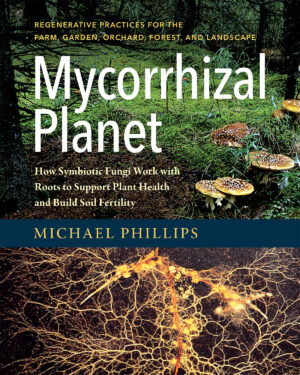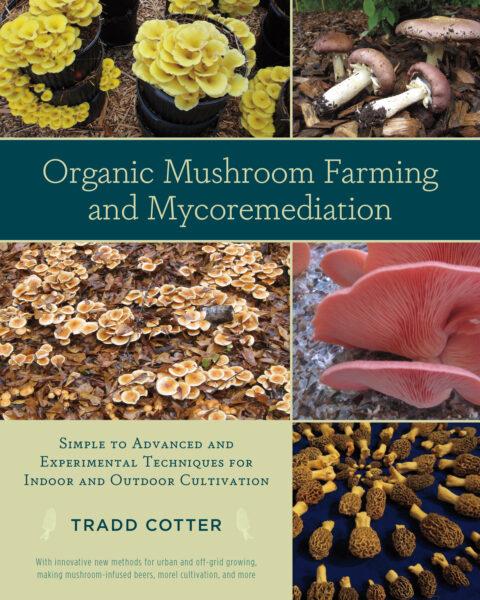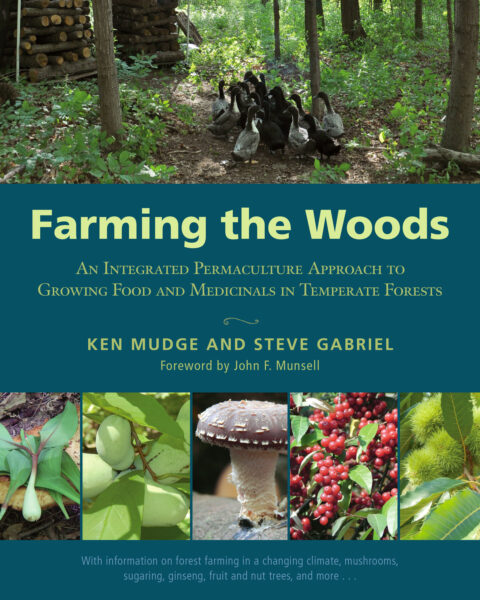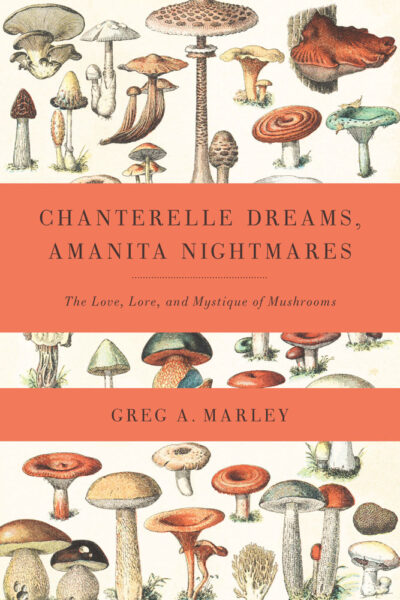Foraging for Mushrooms: Gourmet Root Systems
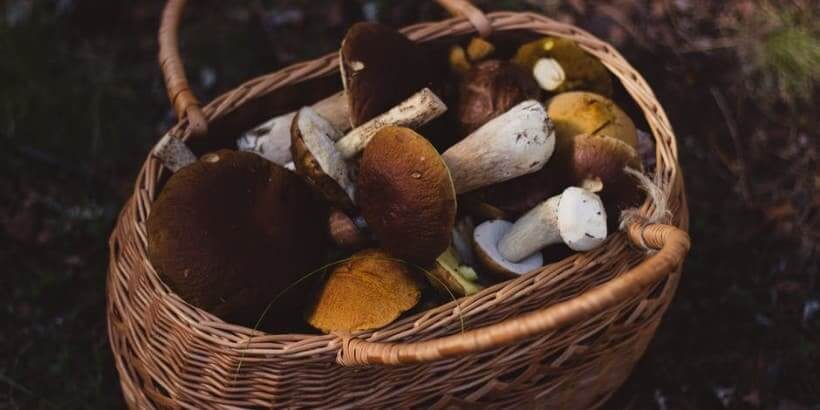
For people who enjoy foraging for food in the wild, there are plenty of mushrooms to choose from — “ten thousand mushroom species to be considered on the North American continent alone”.
But foraging for mushrooms should never be thought of as a game of chance. You need to know all the clues when it comes to identifying any mushroom as edible. Michael Phillips has a few handy tips for locating the true delicacies of the forest floor.
The following excerpt is from Mycorrhizal Planet by Michael Phillips and been adapted for the web.
Call this the symbiosis benefit especially for us.
Ectomycorrhizal species evolved from saprotrophic fungi with fruiting bodies. What an entirely delectable trait to pass along!
I claim few talents as a stalker of edible mycorrhizal mushrooms. The occasional morel on abandoned apple ground, the golden glow of chanterelles easily found—knowing these gifts are out there is happiness in itself.
Yet now I’m motivated to spend even more time in the woods, thanks to inspiring friends with tried-and-true mushroom abilities. What follows is an introduction to an array of edible wonders.
This is by no means a mushroom identification guide . . . you’ll need one or more of the titles suggested at the end of this chapter to be sure.
We begin with the unquestionable tie between mycorrhizal mycelia and the root systems of certain tree species.
Identifying trees is part of the skill set needed to know where to best look for these mushrooms. Some mycorrhizal fungi form partnerships specifically with manzanitas and madrones, for instance, along the Redwood Coast.
Other species are found only with alders, or with certain pines, or with beech. On the other hand, the same tree can have numerous mycorrhizal affiliations and thus offer prospects for different fungi at different points in the year.
According to David Arora, author of Mushrooms Demystified, “[t]here are well over 1,000 kinds of mushrooms known to form mycorrhiza with Douglas fir, and the great Douglas fir forests of the Pacific Northwest are among the best fungal foraging grounds in the world.”
Mycelia extend further than the canopy stretch of a single tree, so cast your eyes broadly across the forest floor.
The “tree viewpoint” becomes more about recognizing the right sort of forest ecosystem where desirable mushrooms will be found.
My better chanterelle finds have come in mixed stands that include balsam fir; the same place where others report finding boletes. Mature hemlocks along streambeds are noted for being a good place to look for dozens of species, including matsutake.
The oak family supports many species including king boletes, chanterelles, and black trumpets. Birches are a well-known source of chanterelles, hedgehogs, and the more disconcerting webcap.
Let’s zone in all the more as to the right sorts of places to look. Mixed stands of hardwoods and conifers provide a variety of habitats for mycorrhizal collaboration.
Mature trees are more likely to offer a prize than a younger, successional stand.
Look for sphagnum moss, in part because mosses reflect nondisturbance and thus fungal continuity. Well-shaded embankments along back roads and trails are prime mushroom ground. Any microclimate that holds moisture tends to be a good fungal bet.
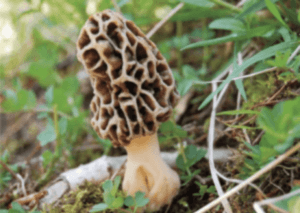
Yellow morels are one of the most readily recognized of all the edible mushrooms. Photo by Mary Smiley, Creative Commons.
Establishing mycorrhizal mushrooms at one’s own place requires patience. The first step involves getting mycelium growing on the right sorts of trees . . . and then you wait and wait some more.
Years may pass before a single fruiting body shows itself.
The “lottery approach” involves distributing spores from forest finds on promising tree sites.
Overly mature specimens or stem butts serve well here. Scratch these slightly into the ground to get closer to the proximity of actual roots.
The odds may be slim that the new species takes up residence (by which point you will have forgotten all about it anyway!), but those spores will indeed germinate.
Only time will tell if an introduced species can wriggle its way into an established fungal scene.
Transplanting saplings from proven mushroom ground brings with it the expectation that those root systems will carry the same mycorrhizal connection along.
This holds slighter better promise, only it may be a decade or more before those trees come into their own and that first mushroom says here I am.
Similarly, you can make root dip inoculum by crushing the spore-bearing surfaces of wild mushrooms (dried and held over from the previous fall) into water and then immersing the roots of appropriately matched nursery stock prior to planting those seedlings in early spring.
Chances of success rise if such root systems have no dominant ectomycorrhizal affiliation to start.
Morels are among the better mycorrhizal candidates for establishing on home ground. These mushroom species work in a broad range of host situations thanks to a ready ability to adapt. Some form mycorrhizal associations directly, while others express a modus operandi that’s more saprotrophic.
Some believe that morels are disrupted out of a healthy symbiosis when a tree dies for whatever reason . . . causing the fungus to withdraw from the roots, form sclerotia (compact masses of hardened mycelium, with food reserves), which then go into fruiting mode separate from the tree in order to sporulate and find new hosts.
This dual nature goes a long way toward explaining the settings where these delectable mushrooms can be found.
Savvy morel hunters know to look near ash, oak, and wild cherry trees in forests with moderately well-drained soils. Cottonwoods and tulip poplars are good indicators of yellow morels in the vicinity. Mushroom hunters from Tennessee claim to find these just as often under red cedar.
Mass fruitings of black morels follow forest fires in the coniferous forests of the Intermountain West. Morels continue to feed off the root systems of dead elms and apple trees in abandoned orchards as true saprobes. Morels are even found in gravelly roads and streambeds on a go-figure basis.
Conditions are right early in the spring as the ground is warming.
Morels will first appear on south-facing slopes in fairly open areas. As the season progresses, the place to be is deeper in the woods on the north-facing slopes. The season begins when trillium flowers bloom and redbud trees burst forth with color.
Here in northern New England, morels peak when apple and lilac bloom overlaps. Morel season can be very short in southern regions when it gets very hot and dry early, while the cool, wet weather often experienced further north is conducive for stretching out the harvest window to a full month long.
You’ll find strategic tips for cultivating morels in Organic Mushroom Farming and Mycoremediation by Tradd Cotter.
Regional strains have a strong affiliation, not only for specific tree types, but importantly for the soil microbe community found in each place. Positioning a nonnutritive layer between the spawn and wood chip substrata is integral to getting morels to pop forth the next year.
Native soil—from where the morels being cultivated were found, no less—must be included in the propagation bed to ensure the presence of the right bacterial associates known to that particular morel strain.
Morels are among what mycologists call the Foolproof Four, a list that includes morels,
puff- balls, sulfur shelf mushrooms, and shaggy manes. Each of these mushrooms has a distinctive look that’s easily differentiated from other, poisonous varieties.
The takeaway here is you need to know all the clues when it comes to identifying any mushroom as edible.
Morels have a distinctive conical shape, with a series of cups arranged haphazardly on the head, atop a hollow stem. Yet there are false morels just as there are false prophets . . . so be forewarned.
Chanterelles are delicious, orange-yellow, almost trumpet-shaped mushrooms, said to emit a pleasant apricoty smell.
These are found in many kinds of woodland and are fairly easy to spot at that because of their glowing vibrancy from head to toe. The fruiting body can persist as long as two to three weeks, so leave the smaller ones to expand in size for later picking.
Look to mossy areas where the right tree associates grow nearby. This can be anything from oak and beech to hemlock and pines, whether found in uplands or lowlands.
David Spahr in Maine points out that the edge of a dirt road or trail can be especially promising, perhaps because the compacted earth to be found in such places causes the mycelium to react by fruiting heavily.
July through September marks the months to be on the lookout for chanterelles, especially in those years with consistent summer rains.
One of the identifying features of a true chanterelle is the “false gills” on the underside of the cap.
These are not individual structures that sit separate from one another but rather are mere folds in the undersurface of the fruiting body.
Assessing true or false gills is especially important if one wants to eat chanterelles, since the poisonous Jack O’Lantern mushroom is a cluster-growing lookalike with true, rather than false, gills.
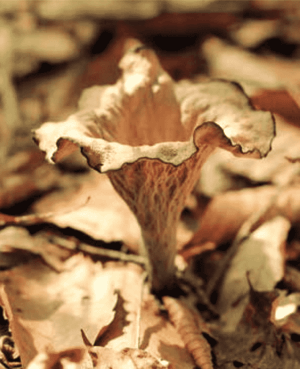
The black trumpet rates as one of the best-tasting mycorrhizal mushrooms. Photo by Tammy Sweet.
The ability to hide—and hide quite well at that—belongs to the black trumpet grouping of mycorrhizal mushrooms.
All species are not only edible but among the very best in flavor. Black trumpets will be called the black chanterelle or horn of plenty in some regions.
These funnel-shaped mush- rooms can be tan to light gray early on, darkening to dark gray or black at full maturity.
The fruiting bodies range in height from 1–6 inches (2.5–15 cm) and up to 3 inches (7.5 cm) across. The flesh is thinner than most, and extremely fragrant.
Small clusters are typically found in mixed woods where beeches and oaks grow, especially shady and damp locations.
Those so-called spring washes where snowmelt runs off hillsides as a visible stream (and does the same after a heavy rain in a wet summer) are bonanza territory for trumpet lovers.
The trick to finding these naturally camouflaged mushrooms is to stand directly overhead, looking down rather than letting your eye rove across the landscape.
Some say that looking for black trumpets is like looking for holes in the ground, which isn’t far from the truth.
Hedgehog mushrooms are known as tooth fungi, so named because of spinelike bristles on the undersides of their caps.
The sweet, nutty taste and crunchy texture give these mushrooms a high rating in the kitchen. The cap starts off lightly colored, picking up a yellow to light-orange to even brown hue by maturity.
Hedgehogs often develop an irregular shape, especially those crowded in closely with adjacent fruiting bodies. This basidiomycete has no poisonous lookalikes and will rarely be bothered by slugs or other insects.
Hedgehogs associate regularly with Scots pine and hemlock, and occasionally with beech and yellow birch. Tooth fungi can be found growing on bare ground, such as eroded river gravels, likely assisting trees to stretch roots into new territory.
These mushrooms grow in profusion in the leaf litter of both coniferous and deciduous forests.
Fruiting occurs from midsummer through the autumn months.
Concealed under duff on the forest floor, matsutake mushrooms come on strong by September. These highly sought-after mycorrhizal mushrooms grow across all the northern temperate zones. Species on each continent are classified separately, but in truth they are much the same.
Tricholoma magnivelare is found in the coniferous forests of the Pacific Northwest, is associated with low-growing hardwoods in California and parts of Oregon, and is generally found in jack pine and hemlock forests in the Northeast.
The North American variant is typically called “white matsutake,” as it does not feature the brown coloration of the Asian strain.
The odor of the matsutake is its most distinctive yet hard-to-characterize feature. David Arora described it as “a provocative compromise between red hots and dirty socks,” and so it may be.
The fungus often grows in fruiting arcs through the soil as root outreach extends further each year. Matsutake favor what are known as podzol soils. This gray clayey, somewhat sandy earth is the third layer below a needle layer and a thin humus layer, followed by subsoil.
The king bolete is a delicious, meaty mushroom that grows worldwide. Its many names include porcini and pennybun, comprised of several closely related species with similar looks, habitat, and flavor.
These stately mushrooms feature a thick cap, with a distinctive spongelike texture on the underside.
Their clubbed stem often appears to be covered in fine webbing (reticulation). Boletes have a strong affinity for spruces and, depending on how the species is defined, other conifers and even hardwoods.
The choicest specimens can be served raw, thinly sliced with lemon juice and oil . . . though more typically boletes will be sautéed in their own juices. These prized mushrooms have a very short life cycle, harvestable for just a few days before turning into maggot hotels and soon after that into a puddle of black slime.
The best things in life are often ephemeral.
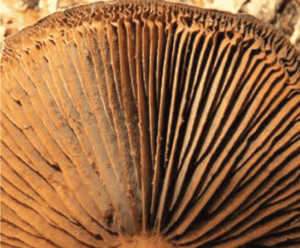
The magnificent gills of Cortinarius armillatus are but one indicator of an edible mushroom with some very poisonous cousins. Photo by David Spahr.
Edible, of course, doesn’t necessarily mean a thing is worth eating. The impressive-looking Cortinarius armillatus is mycorrhizal with white birch, and is a common late-summer and fall mushroom in northern forests.
The stem has a swollen base, with a series of two to four bright, orange “bracelets” encircling the stem.
Its genus name is a reference to the partial veil or cortina (meaning ‘a curtain’) that covers the true gills when caps are immature.
Other species in this family associate with big-toothed aspen, beech, balsam fir, white pine, red pine, assorted spruces, and ericaceous shrubs. The reddish variants of webcaps contain orellanine and are known to be deadly poisonous.
The question is, why bother to eat one with a bland radish odor when its not-so-nice cousins of similar appearance could finish you off?
The fruiting bodies of truffles grow underground and are sought out by gourmet chefs the world over.
These mycorrhizal treasures are harvested traditionally in Europe with the aid of female pigs, which are able to detect the strong smell of ripe truffles beneath the surface of the ground, and then become excited.
This plan comes with risk, however, because of a pig’s natural tendency to eat whatever is remotely edible. Enter the truffle dog, willing to exchange that smelly ol’ soil ball for a treat and a pat on the head.
The flavor of the truffle is directly related to its aroma.
This reaches peak essence only after the spores are mature enough for release, so truffles must be collected at the proper time or they will have little taste.
The resulting flavor can be described as garlicky with cheese overtones . . . yet there are species that come across tasting more like tar with a delicate hint of methane.
The point being it matters which tuber fungi of some two hundred identified species are the truffles of choice. The Italian white truffle comes with the highest regard, followed by the Périgord black truffle of France.
The Burgundy truffle was held in great esteem in Victorian times. Here in North America, the Oregon white truffle is making waves of its own.
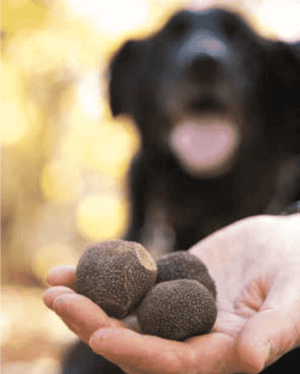
The highly rated black truffle often requires a well- trained dog nose to detect these buried treasures. Courtesy of Australian Truffle Traders.
Appropriate tree seedlings such as oaks and filberts are inoculated with truffle spores and then transplanted out to the proper environment (usually a barren, rock-strewn calcitic soil) to establish a truffière.
This was a hit-or-miss proposition for the longest time until recent understanding about keeping other ectomycorrhizal fungi out of the picture came to be.
It takes nearly a decade before the first truffle begins to grow, with a productive life for the bearing tree expected to last about twenty to thirty years.
Truffle horticulture is fascinating.
Simple things like planting density and tree arrangement hold the key to prolonged production, as the soil surface needs good sun exposure to favor the Tuber genus over other competing fungi.
The truffle has been described as the fungus worth more than gold. I may never taste a finely prepared truffle dish, just as I may never open a thirty-year-old bottle of Bordeaux.
Instead, I got to read a great book on truffles while drinking my own cider, and our dog came by and I gave her a pat on the head. Reality is what we make of it.
The “lobster mushroom” is the result of another fungus parasitizing either a Russula brevipes or Lactarius piperatus mycorrhizal mushroom.
This produces a vivid orange covering over the mushroom, not unlike that of a cooked lobster, the surface of which is rather hard and dotted with tiny pimples. Eventually, the fungus even trans- forms the shape of the host mushroom, twisting it into odd contortions.
These can be found under a variety of trees, with hemlock and Douglas fir as especially good candidates. Most will be found in the fall months, but “lobsters” can appear undergoing transformation as early as July.
These mushrooms are very noticeable: Nothing else looks remotely like fungi taken to the second power.
Laccaria laccata, commonly called waxy laccaria, is a white-spored species of small edible mushroom found throughout North America and Europe.
This highly variable mushroom can be deceiving, eventually looking quite washed out, even drab, though when younger it often assumes red, pinkish-brown, and orange tones.
Some consider this species to be a “mushroom weed” because of its ubiquity and plain stature. Waxy laccaria taste mild; however, before tasting, you need to distinguish it from other potentially lethal, small brown mushrooms also found in mixed forest ecosystems.
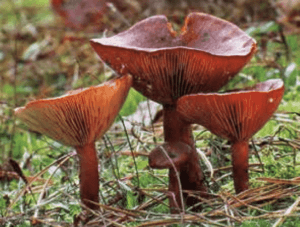
The Red Hot Milk Cap tastes mild initially, gradually becomes extremely hot, and then burns you to a crisp. Photo by Zonda Grattus, Creative Commons.
Lactarius rufus is more commonly known as the Red Hot Milk Cap.
Its delayed-action effect masks an extremely hot (maybe the hottest) mushroom.
These can be used as a condiment only after processing with vinegar or salt. The flesh exudes a milky latex fluid when the tissues are damaged.
This entire genus of mycorrhizal fungi is dependent on the occurrence of specific host plants, and in this case, that would be pine trees followed by birch or spruce.
These mushrooms appear from late spring to late autumn in northern zones.
We’re ending this appropriately enough with a visual delicacy found between the start of fall colors and the onset of snow.
Purple-gilled laccaria are mycorrhizal with hardwoods and conifers, growing alone or scattered about in pairs or grouped gregariously.
These mushrooms are especially partial to oak and beech, but will also frequently be found in young stands of white pine.
This species is easy to identify with its whitish-cream cap and dark-purple to light-purple gills underneath and a hard (not quite chewable), fibrous stem.
Laccaria ochropupurea have a pleasant mushroomy flavor, just right for adding to a hearty bean soup or venison stew left to simmer on the wood cookstove as the days grow shorter.
Identifying edible mushrooms starts to get tricky really quick. Field guides with numerous photos go a long way toward showing the important indicators, but what really counts, in order to be sure, are spore print patterns and understanding fungal anatomy in every respect.
Join a local mushroom club and go out foraging with folks who really know.
The ten thousand mushroom species to be considered on the North American continent alone (and that’s a conservative estimate) include saprotrophic fungi as well as these mycorrhizal kin.
Recommended Reads
Recent Articles
Garlic mustard: while known as “invasive,” this plant can be consumed in its entirety and has great nutritional value. Plus, the garlic-flavor is a perfect addition to any recipe that calls for mustard! The following are excerpts from Beyond the War on Invasive Species by Tao Orion and The Wild Wisdom of Weeds by Katrina…
Read MoreEveryone loves a refreshing, fermented, nutritious drink…even your garden! Take your fermentation skills out of the kitchen and into the garden by brewing fermented plant juice. The following is an excerpt from The Regenerative Grower’s Guide to Garden Amendments by Nigel Palmer. It has been adapted for the web. How to Make Fermented Plant Juice Fermented…
Read MorePeregrine falcons, while known as predators, are essential to our environment. These stunning birds have a rich history, an interesting present, and an uncertain future. The following is an excerpt from Feather Trails by Sophie A. H. Osborn. It has been adapted for the web. Who Are Peregrine Falcons? Though relatively uncommon wherever it occurs,…
Read MoreWant to see your crops thrive this upcoming growing season? The key is in soil fertility and health. Spend time maintaining your soil’s health to guarantee bigger and better crops come harvest time! The following is an excerpt from No-Till Intensive Vegetable Culture by Bryan O’Hara. It has been adapted for the web. What Is Soil Fertility?…
Read MoreMany know the effects of catnip on our feline friends, but few realize that catnip has medicinal effects for humans. From stomach aches to reducing fevers, catnip is a versatile herb with many benefits. The next time you grow this plant for your cat you may end up taking a few cuttings for yourself! The…
Read More

